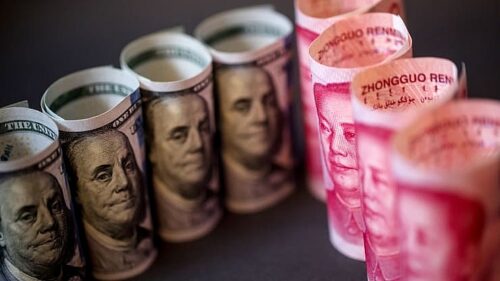>>REAL-TIME UPDATES IN THE WIRE. CLICK HERE<<<
The Chinese yuan weakened sharply on Tuesday after the central bank cut policy rates to boost the slowing economic recovery and as the yield gap between Chinese and US government bonds widens.
The offshore yuan weakened by as much as more than 400 pips on Tuesday to break through 7.32 per dollar mark at one point, while the onshore yuan depreciated by as much as 331 pips to break through 7.28 per dollar mark before closing at 7.2868 per dollar.
Before the market open, the People’s bank of China cut the yuan’s fixing by 82 pips to 7.1768 per US dollar, representing a deviation of 769 pips from the onshore yuan’s closing price of 7.2537 per dollar one day earlier.
Since May this year, the yuan has been under pressure, weakening by more than 5% from around 6.5 per dollar to around 7.25 per dollar within two months. After rebounding to around 7.15 per dollar in mid- to late-July, the currency resumed depreciation in early August and has weakened by around 2% so far this month.
Analysts say that the latest depreciation was due to trading factors as well as macro factors. On one hand, China has been in a rate-cut cycle, which led to continuous declines in the yield on Chinese government bonds. So far this year, the yield on the 10-year government bond has declined by nearly 10%.
On Tuesday, the yield on the 10-year government bond hit 2.5650%, the lowest level since 2020, after the PBOC cut two key policy rates to boost the weakening economic recovery. Meanwhile, the yield on the 10-year US treasury bond reached 4.21% on Tuesday, leaving a gap of 1.65 percentage points.
Looking ahead, the yuan will likely see more depreciation pressure in the short term mainly due to the rising yield on US treasury bonds, said Wang Tao, chief China economist at UBS.
The data released by the government on Tuesday showed that China’s economic activities, including industrial output, retail sales and investment in July were broadly weaker than expected, which leads to more downward pressure on the currency.
Earlier data has shown that China’s trade and credit growth also showed weakness and some highly-leveraged industries’ liquidity risks has been increasing, adding pressure on the yuan, said Wang Youxin, analyst at Bank of China.
China’s economic recovery in the second half of the year will likely see more challenges, market entities may continue to hold a wait-and-see attitude, and the yuan is expected to remain under pressure in the short term, according to Kaiyuan Securities.
As the economic growth in the US is slowing, its rate-hiking cycle is coming to an end, while the Chinese economy is at the bottom with some recovery expected, “the yuan will likely strengthen slightly against the US dollar by the end of the year, likely to recover 7 per dollar mark,” said Wang.

